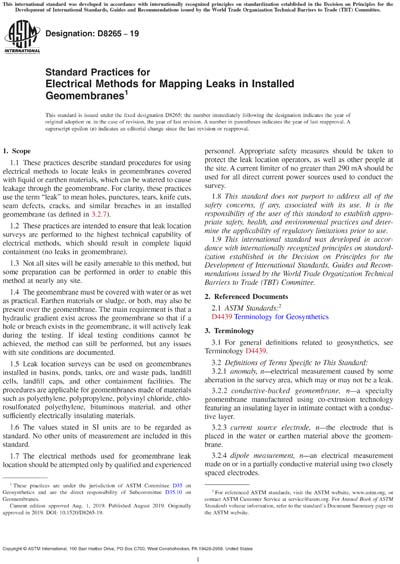Historical
ASTM D8265-19
Standard Practices for Electrical Methods for Mapping Leaks in Installed Geomembranes
1.1 These practices describe standard procedures for using electrical methods to locate leaks in geomembranes covered with liquid or earthen materials, which can be watered to cause leakage through the geomembrane. For clarity, these practices use the term “leak” to mean holes, punctures, tears, knife cuts, seam defects, cracks, and similar breaches in an installed geomembrane (as defined in 3.2.7).
1.2 These practices are intended to ensure that leak location surveys are performed to the highest technical capability of electrical methods, which should result in complete liquid containment (no leaks in geomembrane).
1.3 Not all sites will be easily amenable to this method, but some preparation can be performed in order to enable this method at nearly any site.
1.4 The geomembrane must be covered with water or as wet as practical. Earthen materials or sludge, or both, may also be present over the geomembrane. The main requirement is that a hydraulic gradient exist across the geomembrane so that if a hole or breach exists in the geomembrane, it will actively leak during the testing. If ideal testing conditions cannot be achieved, the method can still be performed, but any issues with site conditions are documented.
1.5 Leak location surveys can be used on geomembranes installed in basins, ponds, tanks, ore and waste pads, landfill cells, landfill caps, and other containment facilities. The procedures are applicable for geomembranes made of materials such as polyethylene, polypropylene, polyvinyl chloride, chlorosulfonated polyethylene, bituminous material, and other sufficiently electrically insulating materials.
1.6 The values stated in SI units are to be regarded as standard. No other units of measurement are included in this standard.
1.7 The electrical methods used for geomembrane leak location should be attempted only by qualified and experienced personnel. Appropriate safety measures should be taken to protect the leak location operators, as well as other people at the site. A current limiter of no greater than 290 mA should be used for all direct current power sources used to conduct the survey.
1.8 This standard does not purport to address all of the safety concerns, if any, associated with its use. It is the responsibility of the user of this standard to establish appropriate safety, health, and environmental practices and determine the applicability of regulatory limitations prior to use.
1.9 This international standard was developed in accordance with internationally recognized principles on standardization established in the Decision on Principles for the Development of International Standards, Guides and Recommendations issued by the World Trade Organization Technical Barriers to Trade (TBT) Committee.
Content Provider
ASTM International [astm]






